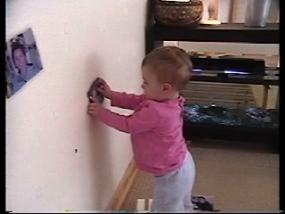Velcro Photographs

A young child attaches photographs, with a Velcro backing, to a cloth wall. This brief video offers us many stories about the child’s knowledge and learning. For example, the story in this video could be about the child’s persistence. Notice that when the photograph she placed on the wall drops to the floor, she does not give up (00:12). Instead, the girl bends down to pick up another. Also observe that the child encounters difficulty grasping the photographs from the floor but continues in her efforts until she is successful (00:14, 00:38).
This video also demonstrates the child’s knowledge about photo literacy. With a great deal of fluidity, she shows her understanding that each photograph has a front and a back, a right-side up and an upside down. On each occasion the child picks up a photograph, notice that she turns it around to look at the image on the front (00:02, 00:20, 00:48). When required, the girl reorients the photograph so the people in the photo are right side up (00:49). Also notice that the girl consistently puts the pictures on the wall right side up without hesitation (00:09, 00:23, 00:50).
Another story in this video is the child’s physical knowledge about how things stick. Notice that she presses the first photograph against the wall and says, “stuck,” even before releasing her grasp (00:10). The girl anticipates the photograph will stick, perhaps because she notices the other photograph stuck on the wall. On the next try, she orients the second photograph in the same manner and adjusts her strategy only by moving to a different location (00:21). The child may understand that the Velcro side of the photo card plays an important role in making the photograph stick. Interestingly, she focuses much of her attention on the Velcro strip when working to pick up the next photograph from the floor (00:38). Later, observe that the girl removes a photograph from the wall and holds it in her left hand, while making a circling movement as she touches the wall by rubbing with the flat of her right hand. Notice that she changes the flat hand into a pointer finger as she touches the small piece of Velcro stuck on the wall (01:01). The girl articulates a higher pitched utterance as she turns to look at the place she is pointing, perhaps indicating her belief that the piece of Velcro has importance. She then changes her technique again by dragging the flat of her hand along the wall as if to rub the Velcro (01:02). Throughout the episode, notice the girl’s tendency to tilt her head to the side as she places the photographs on the wall. This action could suggest she is thinking about the process of the photo card adhering to the wall. Observe that she presses and holds each photograph against the wall as if to allow time for it to become stuck. Although unseen, she seems to know that something takes place. She may tilt her head as a way to mark this “press and hold” step in the process of becoming "stuck".
The story in this video could also be about the child’s sense of social affiliation. Notice that when the girl looks at a photo image she sometimes makes a sound. For example, she looks at the image of two people portrayed on the second photo card and she says something like, “da bee, ba,” before placing it on the wall (00:21). Near the end of the clip, the girl places a photograph containing the image of one, large head on the wall. Notice that as she backs up she utters, "da du duep," and purses her lips looking all the while at the photo (01:21). Also notice that in two instances, the girl places a photograph on the wall, backs up while looking at the photo, and utters a sound of pleasure (00:25, 00:52). When considering whether the girl may recognize the photo content, decide if you think she would be so delighted if the photo cards were blank.
The environmental set-up of the materials could be another story in this video. If the photographs had a loop of string on the back she would need to look for a hook. If the photographs themselves had a hook on the back, she would have to look for a loop of string. But the photographs have Velcro on the back, so she has to press the cards onto the wall. We might learn more about the child’s understanding of orientation (photo literacy) if some of the photographs were cropped into circles and mounted on cardboard discs. We may also gain a better understanding of the child’s preferences and knowledge of symbols, if some of the photo cards were blank. Similar to a storyboard, if photographs that portrayed actions were included, the child may be encouraged to place the photos in an action sequence.
Length of stand-alone master video clip: 1 minute 23 seconds
Highlight the text above and paste to a document to have your own copy.
Keywords: Ones, Child-Object, Spatial Relations, Persistence, Literacy, Adhesiveness, Photographs
